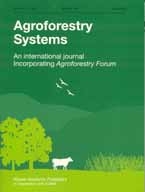| Journal Article |
 |
|
| Article Title | Soil property changes in contour hedgerow systems on sloping land in the Philippines | | Author | S Samsuzzaman, Dennis P Garrity and R U Quintana | | Year | 1999 | | Journal Title | Agroforestry Systems | | Institution | Kluwer Academic Publishers | | Volume | 46 | | Issue | 3 | | Pages | 251-272 | | Call Number | JA0135-04 | | Keywords | Acid soil, alley cropping, hedge-crop competition, nutrient dynamics, soil fertility, sustainability |
|
| Abstract: |
| The impact of contour hedgerow systems on soil sustainability under acidic condi-tions
has been widely criticized. A study was undertaken to determine the effects of manage-ment and hedgerow species on soil properties. Cassia spectabilis (a non-N-fixing tree legume), Gliricidia sepium (an N-fixing tree legume), Pennisetum purpureum (a forage grass), and Stylosanthes guyanensis (a forage legume) contour barriers were compared with an open field
(non-hedgerow treatment) over one cowpea and two rice seasons. Three types of management viz.: prunings applied + N0 P0 K0 , prunings applied + N50 P20 K20 and prunings removed + N50 P20 K20
were used as subplot treatments. The soils were strongly acidic (pH 4.5) and classified as clay Orthoxic Palehumult. Cassia performed better than the other species in terms of pruning biomass, N and P contributions over a period of 20 months. There was a combined positive effect of pruning biomass and fertilizers on rice and cowpea yields in Pennisetum and Gliricidia systems, while a tendency towards a positive effect of pruning biomass on rice was found in the Cassia system. The pruning biomass and/or fertilizer application did not significantly influence the top soil organic C, N and available P in the hedgerow systems. Soil bulk density was significantly reduced by the application of Cassia prunings after 12 months. Organic C, N and P dynamics indicated that in situ pruning biomass was not sufficient to maintain their level in the soil. But the cassia systems with prunings applied + N50 P20 K20 experienced the lowest degradation in
soil organic C (2.1 t ha –1 ) followed by the Gliricidia systems (4.1 t ha –1 ). The overall results imply that the application of pruning and inorganic fertilizer is imperative to conserve soil resources, and non-N-fixing tree species can exert a significant advantage in biomass and thereby in soil N-recycling under acidic soil. |
|
|
Download file(s): Click icon to download/open file.
|
| |
File Size |
Description |

|
81 KB |
Softcopy |
|
|
|
| Viewed in 2124 times. Downloaded in 739 times. |